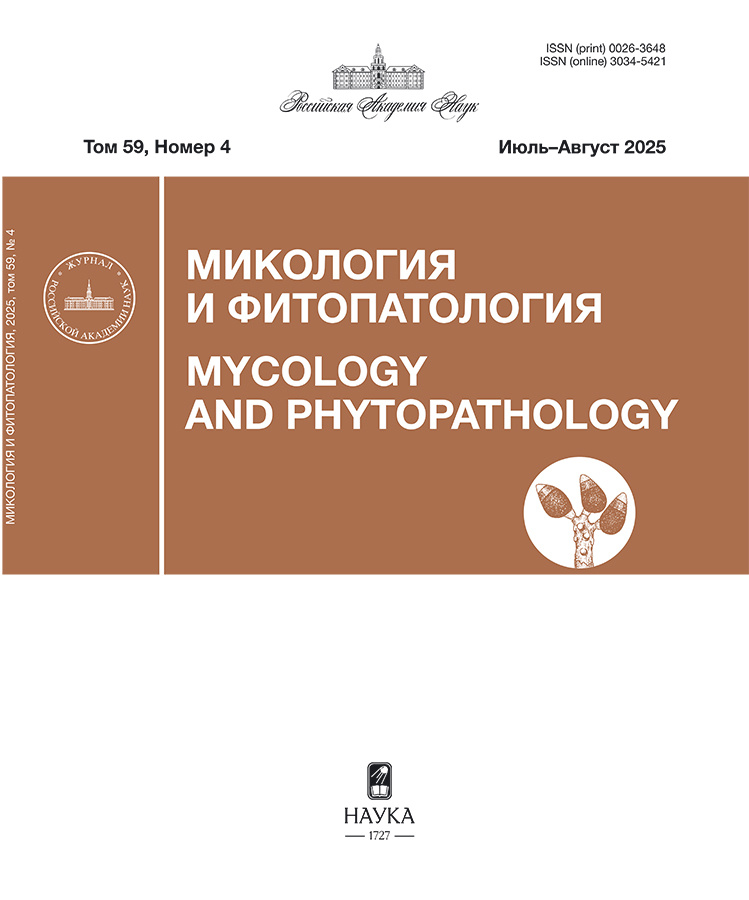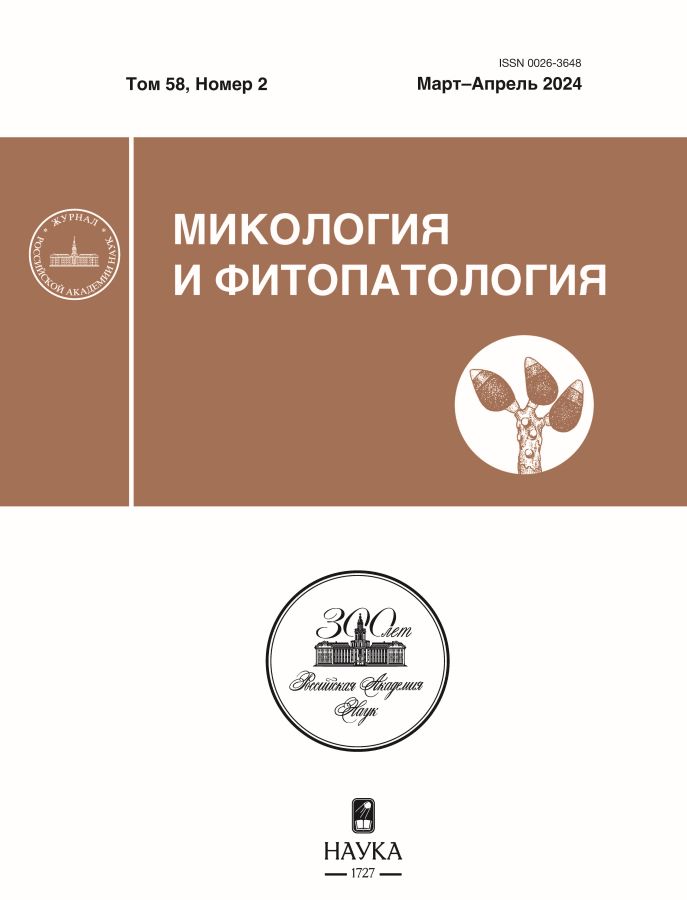Виды рода Fusarium, поражающие клубни картофеля и плоды томата в Уганде
- Авторы: Еланский А.С.1, Миславский С.М.1, Чудинова Е.М.1, Кокаева Л.Ю.1,2, Еланский С.Н.1,2, Денисова E.E.2, Ильичев И.А.2, Белосохов А.Ф.2, Бамутазе Я.3, Музингузи П.3, Ополот Е.3, Красильников П.В.2
-
Учреждения:
- Российский университет дружбы народов имени Патриса Лумумбы
- Московский государственный университет имени М.В. Ломоносова
- Университет Макерере
- Выпуск: Том 58, № 2 (2024)
- Страницы: 161-172
- Раздел: ГРИБЫ – ВОЗБУДИТЕЛИ БОЛЕЗНЕЙ РАСТЕНИЙ
- URL: https://rjraap.com/0026-3648/article/view/655958
- DOI: https://doi.org/10.31857/S0026364824020077
- EDN: https://elibrary.ru/voxjyk
- ID: 655958
Цитировать
Полный текст
Аннотация
Картофель и томат являются одними из наиболее широко возделываемых культур в Уганде. В 2020 г. 22 штамма Fusarium spp. были выделены из клубней картофеля и семь штаммов из плодов томата. Образцы были собраны на фермах в четырех регионах Уганды. Идентификацию видов грибов проводили с использованием культурально-морфологических характеристик и секвенирования части генов фактора элонгации 1 (tef 1) и бета-тубулина (β-tub), а также региона ITS1—5.8S–ITS2 (ITS). Анализ выделенных штаммов из клубней картофеля выявил наличие видовых комплексов Fusarium oxysporum species complex, F. solani species complex, F. sambucinum species complex, F. incarnatum-equiseti species complex. В плодах томата был обнаружен только F. incarnatum-equiseti species complex. Все проанализированные штаммы проявляли способность успешно заражать как поврежденные плоды томата, так и клубни картофеля. Анализ устойчивости к фунгицидам показал, что исследуемые штаммы были чувствительны к дифеноконазолу (ЕС50 = 0.08—8.5 мг/л) и тиабендазолу (ЕС50 = 0.67—5.1 мг/л).
Полный текст
Об авторах
А. С. Еланский
Российский университет дружбы народов имени Патриса Лумумбы
Автор, ответственный за переписку.
Email: sasha.elansky@gmail.com
Россия, Москва
С. М. Миславский
Российский университет дружбы народов имени Патриса Лумумбы
Email: mislavskiy.sm@yandex.ru
Россия, Москва
Е. М. Чудинова
Российский университет дружбы народов имени Патриса Лумумбы
Email: chudiel@mail.ru
Россия, Москва
Л. Ю. Кокаева
Российский университет дружбы народов имени Патриса Лумумбы; Московский государственный университет имени М.В. Ломоносова
Email: kokaeval@gmail.com
Россия, Москва; Москва
С. Н. Еланский
Российский университет дружбы народов имени Патриса Лумумбы; Московский государственный университет имени М.В. Ломоносова
Email: elanskiy_sn@pfur.ru
Россия, Москва; Москва
E. E. Денисова
Московский государственный университет имени М.В. Ломоносова
Email: denisova.elizavet@gmail.com
Россия, Москва
И. А. Ильичев
Московский государственный университет имени М.В. Ломоносова
Email: igor.ilichev.msu@gmail.com
Россия, Москва
А. Ф. Белосохов
Московский государственный университет имени М.В. Ломоносова
Email: arsenybelosokhov.msu.bios@gmail.com
Россия, Москва
Я. Бамутазе
Университет Макерере
Email: yazidhibamutaze@gmail.com
факультет географии, геоинформатики и климата
Уганда, КампалаП. Музингузи
Университет Макерере
Email: patrick.musinguzi@mak.ac.ug
кафедра сельскохозяйственной продукции, факультет сельскохозяйственных наук
Уганда, КампалаЕ. Ополот
Университет Макерере
Email: oplote@yahoo.com
кафедра сельскохозяйственной продукции, факультет сельскохозяйственных наук
Уганда, КампалаП. В. Красильников
Московский государственный университет имени М.В. Ломоносова
Email: pavel.krasilnikov@gmail.com
Россия, Москва
Список литературы
- Abdurahman A., Parker M.L., Kreuze J. et al. Molecular epidemiology of Ralstonia solanacearum species complex strains causing bacterial wilt of potato in Uganda. Phytopathology. 2019. V. 109. P. 1922—1931. https://doi.org/10.1094/PHYTO-12-18-0476-R
- Akbar A., Hussain S., Ullah K. et al. Detection, virulence, and genetic diversity of Fusarium species infecting tomato in Northern Pakistan. PLOS One. 2018. V. 13 (9). P. e0203613. https://doi.org/10.1371/journal.pone.0203613
- Azil N., Stefańczyk E., Sobkowiak S. et al. Identification and pathogenicity of Fusarium spp. associated with tuber dry rot and wilt of potato in Algeria. Eur. J. Plant Pathol. 2021. V. 159. P. 495—509. https://doi.org/10.1007/s10658-020-02177-5
- Borisade O.A., Uwaidem Y.I., Salami A.E. Preliminary report on Fusarium oxysporum f. sp. Lycopersici (sensu lato) from some tomato producing agroecological areas in Southwestern Nigeria and susceptibility of F1-resistant tomato hybrid (F1-Lindo) to infection. Ann. Res. Rev. Biol. 2017. V. 18 (2). P. 1—9. https://doi.org/10.9734/ARRB/2017/34626
- Byarugaba A.A., Mukasa S.B., Barekye A. et al. Interactive effects of Potato virus Y and Potato leafroll virus infection on potato yields in Uganda. Open Agriculture. 2020. V. 5. P. 726—739. https://doi.org/10.1515/opag-2020—0073
- Chudinova E.M., Shkunkova T.A., Elansky S.N. Fungal pathogens of tomato in South-Western Russia (Krasnodar territory). Plant Protection News. 2020. V. 103 (3). P. 210—212. http://dx.doi.org/10.31993/2308-6459-2020-103-3-4998
- Crous P.W., Lombard L., Sandoval-Denis M. et al. Fusarium: More than a node or a foot-shaped basal cell. Stud. Mycol. 2021. V. 98. P. 100116. https://doi.org/10.1016/j.simyco.2021.100116
- Desjardins A.E., Christ-Harned E.A., McCormick S.P. et al. Population structure and genetic analysis of field resistance to thiabendazole in Gibberella pulicaris from potato tubers. Phytopathology. 1993. V. 83 (2). P. 164—170.
- Du M., Ren X., Sun Q. et al. Characterization of Fusarium spp. causing potato dry rot in China and susceptibility evaluation of Chinese potato germplasm to the pathogen. Potato Res. 2012. V. 55. P. 175—184. http://dx.doi.org/10.1007/s11540-012-9217-6
- Gachango E.; Hanson L.E.; Rojas A. et al. Fusarium spp. causing dry rot of seed potato tubers in Michigan and their sensitivity to fungicides. Plant Disease. 2012. V. 96. P. 1767—1774. https://doi.org/10.1094/pdis-11-11-0932-re
- Hanson L.E., Schwager S.J., Loria R. Sensitivity to thiabendazole in Fusarium species associated with dry rot of potato. Phytopathology. 1996. V. 86. P. 378—384.
- Harahagazwe, D., Condori B., Barreda C. et al. How big is the potato (Solanum tuberosum L.) yield gap in Sub-Saharan Africa and why? A participatory approach. Open Agriculture. 2018. V. 3. P. 180—189. https://doi.org/10.1515/opag-2018-0019
- Hellin P., King R., Urban M. et al. The adaptation of Fusarium culmorum to DMI fungicides is mediated by major transcriptome modifications in response to azole fungicide, including the overexpression of a PDR transporter (FcABC1). Front. Microbiol. 2018. V. 9. Art. 1385. https://doi.org/10.3389/fmicb.2018.01385
- Ivanova A.E., Denisova E., Musinguzi P. et al. Biological indicators of soil condition on the Kabanyolo experimental field, Uganda. Agriculture. 2021. V. 11. P. 1228. http://dx.doi.org/10.3390/agriculture11121228
- Kim J.C., Lee Y.W. Sambutoxin, a new mycotoxin produced by toxic Fusarium isolates obtained from rotted potato tubers. Appl. and Env. Microbiol. 1994. V. 60. P. 4380—4386.
- Langerfeld E. Resistance to thiabendazol of Fusarium coeruleum. Nachrichtenblatt des Deutschen Pflanzenschutzdienstes. 1990. V. 42 (5). P. 79.
- Namugga P., Sibiya J., Melis R. et al. Yield response of Potato (Solanum tuberosum L.) genotypes to late blight caused by Phytophthora infestans in Uganda. Am.J. Pot. Res. 2018. V. 95. P. 423—434. https://doi.org/10.1007/s12230-018-9642-4
- Njoroge A.W., Andersson B., Yuen J.E. et al. Greater aggressiveness in the 2_A1 lineage of Phytophthora infestans may partially explain its rapid displacement of the US-1 lineage in east Africa. Plant Pathol. 2019. V. 68. P. 566—575. https://doi.org/10.1111/ppa.12977
- Njoroge A.W., Tusiime G., Forbes G.A., et al. Displacement of US-1 clonal lineage by a new lineage of Phytophthora infestans on potato in Kenya and Uganda. Plant Pathol. 2016. V. 65. P. 587—592.https://doi.org/10.1111/ppa.12451
- O’Donnell K., Kistler H.C., Cigelnik E. et al. Multiple evolutionary origins of the fungus causing Panama disease of banana: Concordant evidence from nuclear and mitochondrial gene genealogies. Proc. Natl. Acad. Sci. USA. 1998. V. 95. P. 2044—2049.
- O’Donnell K., Ward T.J., Robert V.A.R.G. et al. DNA sequence-based identification of Fusarium: current status and future directions. Phytoparasitica. 2015. V. 43. P. 583—595. https://doi.org/10.1007/s12600-015-0484-z
- O’Donnell K., Whitaker B.K., Laraba I. et al. DNA Sequence-Based Identification of Fusarium: A Work in Progress. Plant Dis. 2022. V. 106 (6). P. 1597—1609. https://doi.org/10.1094/PDIS-09-21-2035-SR
- Peters J.C., Lees A.K., Cullen D.W. et al. Characterization of Fusarium spp. responsible for causing dry rot of potato in Great Britain. Plant Pathol. 2008. V. 57. 262—271. https://doi.org/10.1111/j.1365-3059.2007.01777.x
- Peters R.D., Macdonald I.K., MacIsaac K.A. et al. First report of thiabendazole-resistant isolates of Fusarium sambucinum infecting stored potato in Nova Scotia, Canada. Plant Disease. 2001. V. 85 (9). 1030. https://doi.org/10.1094/PDIS.2001.85.9.1030A
- Potato Roadmap Uganda 2021. Ministry of foreign affairs. Haag, 2021.
- Rekanović E., Mihajlović M., Potočnik I. In vitro sensitivity of Fusarium graminearum (Schwabe) to difenoconazole, prothioconazole and thiophanate-methyl. Pestic. Phytomed. (Belgrade). 2010. V. 25 (4). P. 325—333. http://dx.doi.org/10.2298/PIF1004325R
- Srinivas C., Nirmala Devi D., Narasimha Murthy K. et al. Fusarium oxysporum f. sp. lycopersici causal agent of vascular wilt disease of tomato: Biology to diversity. A review. Saudi J. Biol. Sci. 2019. V. 26 (7). P. 1315—1324. https://doi.org/10.1016/j.sjbs.2019.06.002
- Stefańczyk E., Sobkowiak S., Brylińska M. et al. Diversity of Fusarium spp. associated with dry rot of potato tubers in Poland. Eur. J. Plant Pathol. 2016. V. 145. P. 871—884. https://doi.org/10.1007/s10658-016-0875-0
- Tumwine J., Frinking H.D., Jeger M.J. Tomato late blight (Phytophthora infestans) in Uganda. Int. J. of Pest Management. 2002. V. 48 (1). P. 59—64. https://doi.org/10.1080/09670870110094350
- Watanabe M., Yonezawa T., Lee K. et al. Molecular phylogeny of the higher and lower taxonomy of the Fusarium genus and differences in the evolutionary histories of multiple genes. BMC evolutionary biology. 2011. V. 11. P. 322. https://doi.org/10.1186/1471-2148-11-322
- White T.J., Bruns T., Lee S.J.W.T. et al. Amplification and direct sequencing of fungal ribosomal RNA genes for phylogenetics. In: M.A. Innis, D.H. Gelfand, J.J. Sninsky, T.J. White (eds). PCR-protocols and applications — a laboratory manual. Academic Press, San Diego, 1990, pp. 315—322.
Дополнительные файлы














